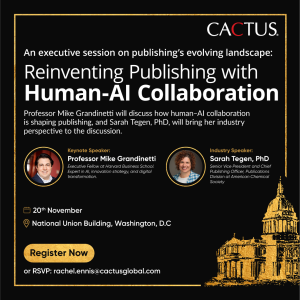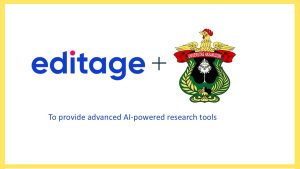It’s no secret that the academic publishing world is changing fast. Over the past few years, new tools and technologies have emerged that make it easier than ever to write content. For researchers, this is exciting because it means they can focus more on their ideas and less on the mechanics of writing. But for editors and journals, it’s a double-edged sword.
The rise of generative AI, including large language models (LLMs) like ChatGPT, has transformed the academic landscape. These technologies are powerful tools for generating content, but their misuse has created significant challenges in maintaining research integrity.
AI tools can generate entire papers, fabricate data and even manipulate images with alarming ease. The pressure researchers feel to “publish or perish” makes them desperate to meet these demands and resort to unethical shortcuts like purchasing fake papers from paper mills. These fraudulent papers, if published undetected, not only damage the reputation of journals, but also waste the time of editors and peer reviewers adding significant overhead costs to the publishing process. Most importantly, they contaminate scientific outputs with ‘junk’, making it difficult to identify good science and trust it.
That’s why upholding standards of research integrity has become more important than ever. Journals need to ensure that every paper they publish is credible, ethical and valuable. But the task isn’t easy, especially when editors are juggling hundreds, sometimes thousands of submissions. Paperpal Preflight for Editorial Desk (PPE) was designed with the goal of tackling this complex challenge.
PPE is an AI-powered tool that helps editors review manuscripts faster and more effectively. By offering three types of checks:
- Language quality
- Research integrity
- Technical compliance.
It gives editors a clear picture of a manuscript’s quality and helps them make informed decisions.
But how does PPE work? What makes it reliable? Let’s take a closer look.
How PPE is Trained: The Technology Behind the Tool
PPE is powered by advanced AI, but what really makes it stand out is how it’s trained. The development process is focused on ensuring that PPE is ethical, accurate and equipped to handle real-world challenges.
The first step is ensuring that all the data used to train PPE is responsibly sourced. PPE relies on publicly available datasets under Creative Commons licenses, following strict permissions and ethical guidelines. Manuscripts uploaded by authors or publishers are never used for training purposes. This means the tool itself operates within the same ethical framework it’s designed to enforce.
PPE’s training covers a wide range of areas to make it as effective as possible.
- Authorship legitimacy: Verifying that the listed authors have actually contributed to the work.
- References/ citations: Checking references and citations to ensure validity.
- Image integrity: Identifying AI-generated images and images that have been duplicated (in part or whole).
- Language quality and technical compliance: Spotting grammar errors, formatting issues, and missing elements required by journals.
This thorough approach ensures that PPE isn’t just looking for one or two issues, it’s assessing the manuscript as a whole.
PPE also builds on the success of an earlier service called IntegrityGUARD, which was designed to provide human-led audits for research integrity. The insights gained from these audits were essential in shaping PPE. By automating many of the checks that used to be done manually, PPE combines the precision of human expertise with the speed of AI. Human experts regularly conduct accuracy tests on the AI checks to ensure that they are accurately identifying compromised manuscripts.
The academic publishing landscape is constantly evolving, and PPE evolves with it. Experts behind the tool regularly monitor new trends and challenges, updating the AI to address emerging issues. This means the tool isn’t just keeping up, it’s staying one step ahead.
Why PPE is an Effective Tool for Editors
PPE isn’t just another tool for research integrity. It is a complete solution designed to support editors with assessing manuscripts more efficiently.
PPE combines three major types of checks—language quality, research integrity and technical compliance – into a single platform, saving the editor’s time and effort of manually cross-checking different reports. Its customizable design allows journals to tailor the tool to focus on specific issues, ensuring nothing important is overlooked.
PPE also provides clear and simple reports with manuscript-level composite score for Research Integrity, rating each manuscript as Pass, Warning, or Critical. This helps the editors quickly determine how much attention a manuscript will require for assessing its quality. This streamlines their decision making and saves valuable time.
With a forward-thinking design that is constantly updated to address emerging challenges, such as new forms of misconduct or changes in compliance standards, PPE remains adaptable and relevant. Unlike tools that specialize in one area, such as plagiarism detection, PPE takes a holistic approach by evaluating the entire manuscript, from ethical compliance to language and technical compliance, making it a reliable and comprehensive partner for editors. Additionally, its scalability and efficiency make it particularly valuable for journals managing high submission volumes, allowing editors to review manuscripts quickly and focus on critical tasks
Conclusion
Research integrity is the cornerstone of academic publishing and tools like PPE are essential for protecting it. By combining advanced AI with human oversight, PPE helps editors navigate the growing challenges of modern publishing.
From detecting ethical issues to ensuring language quality and technical compliance, PPE streamlines editorial workflows and helps maintain the credibility of academic research. As the publishing landscape continues to evolve, tools like PPE will play an increasingly important role in ensuring that journals uphold the highest standards of quality and ethics.
Choose PPE today to achieve authenticity and academic quality in a click. Contact us if you’re interested in leveraging this solution for your editorial desk.









